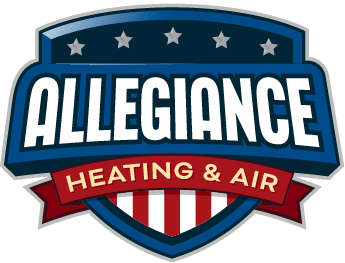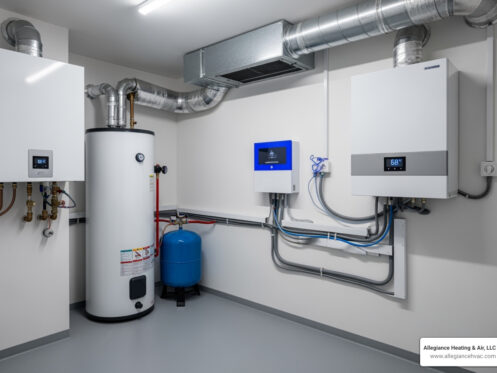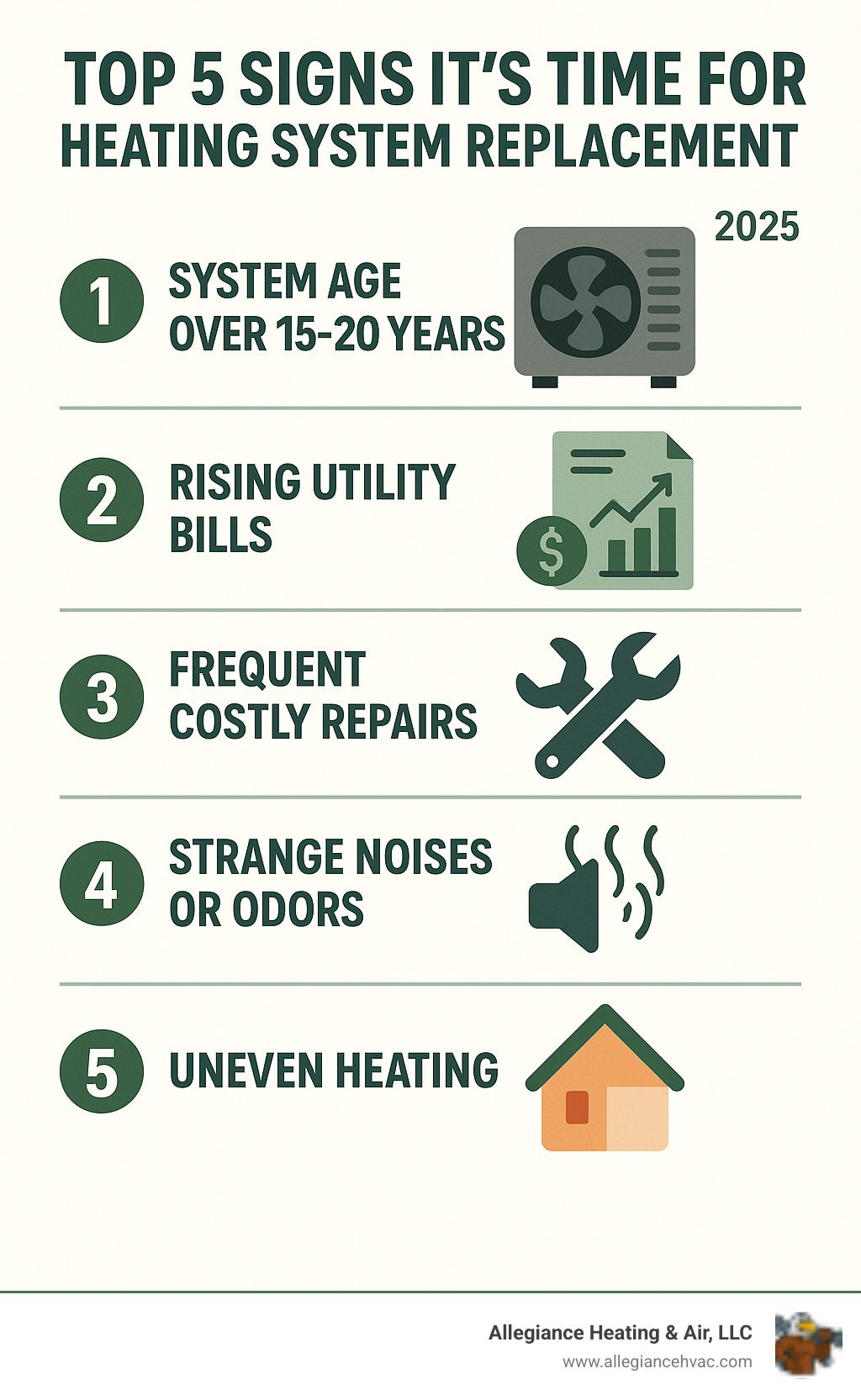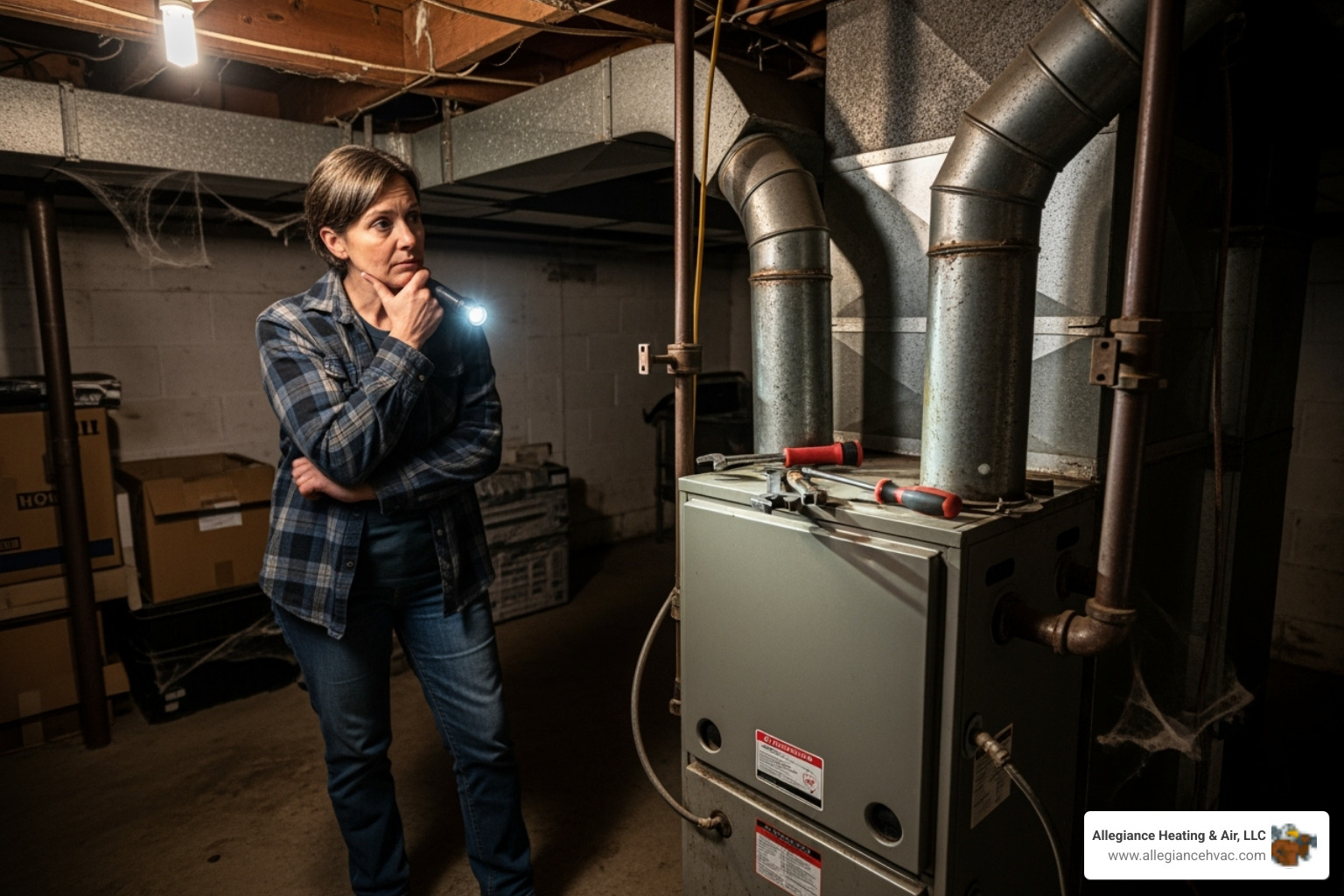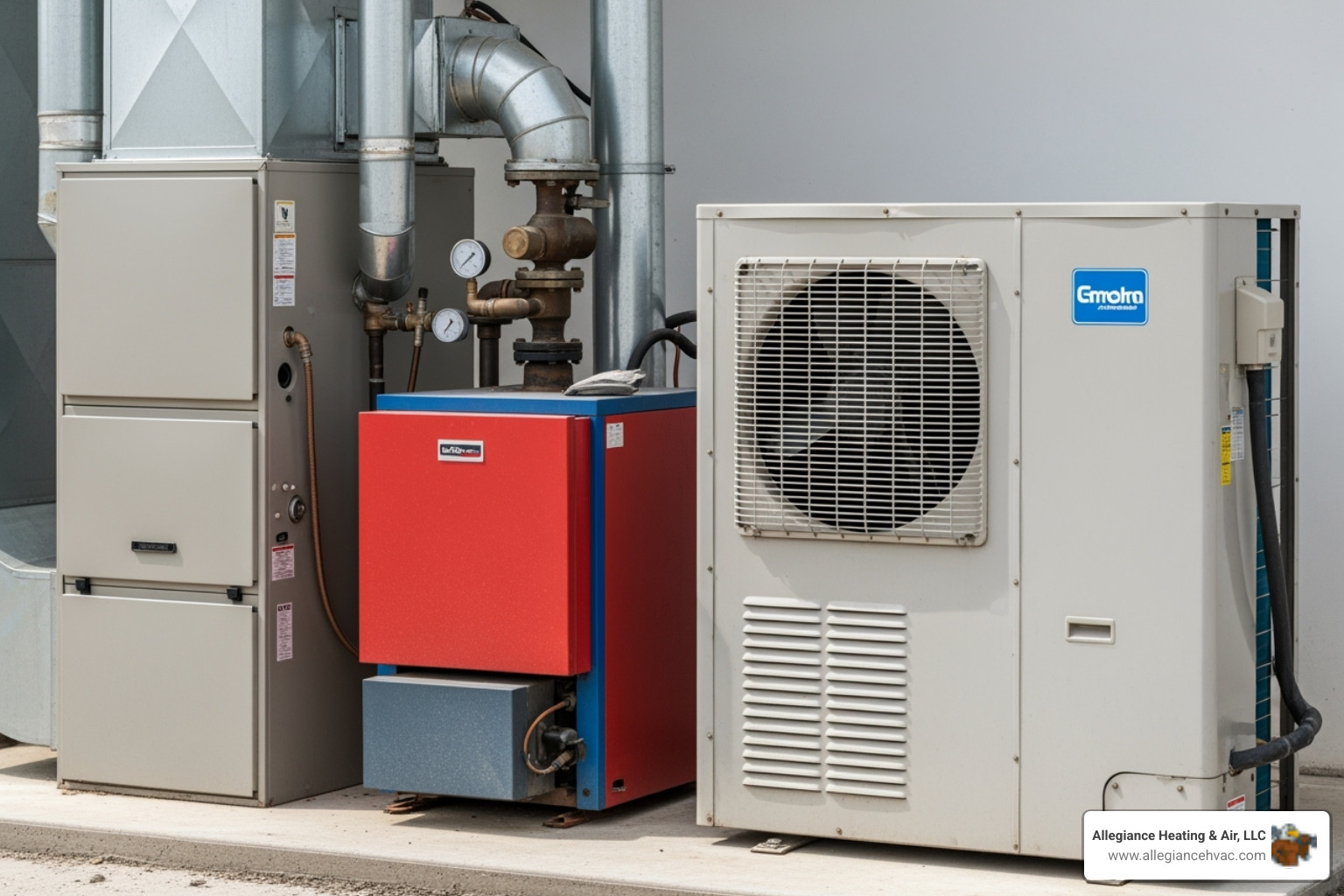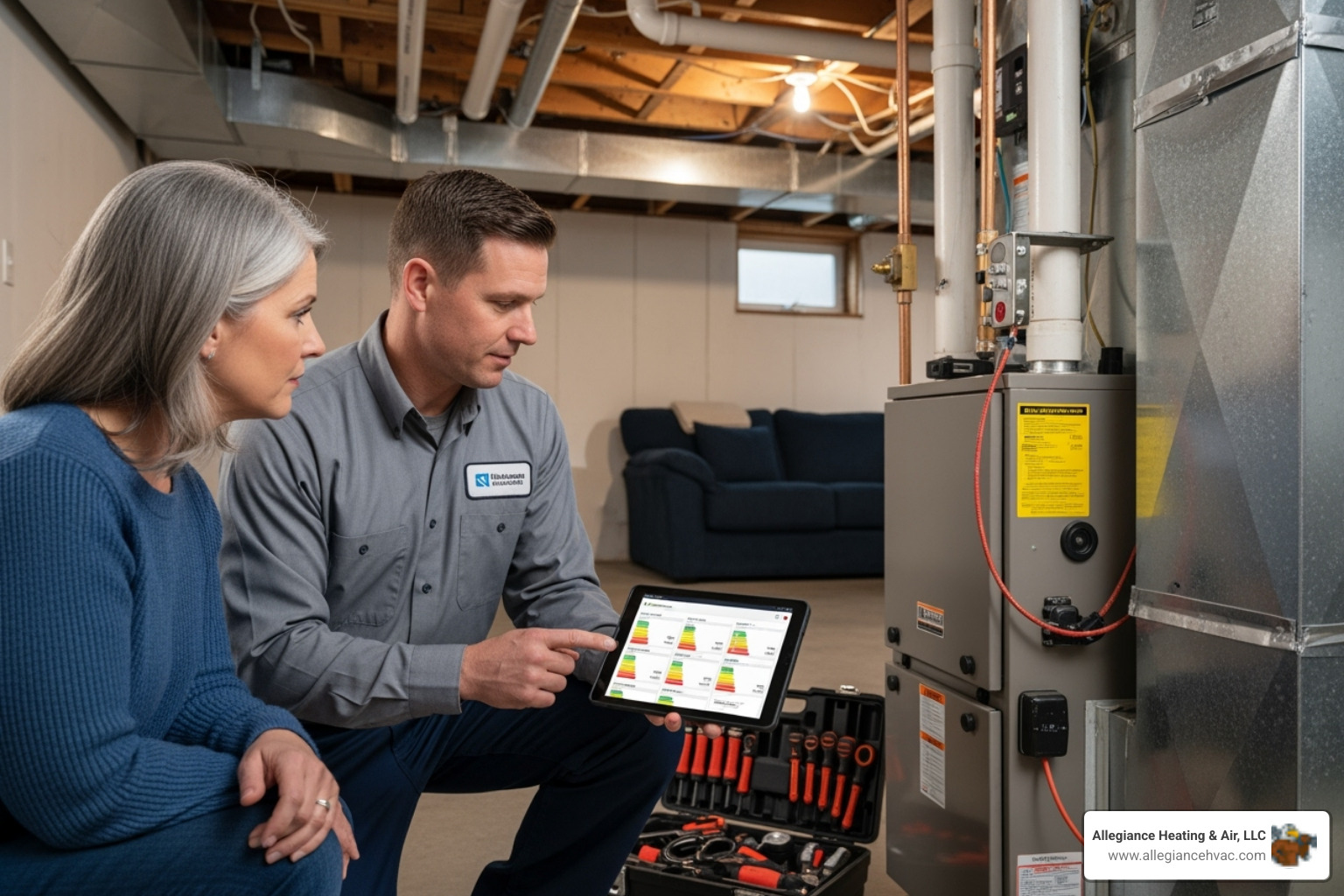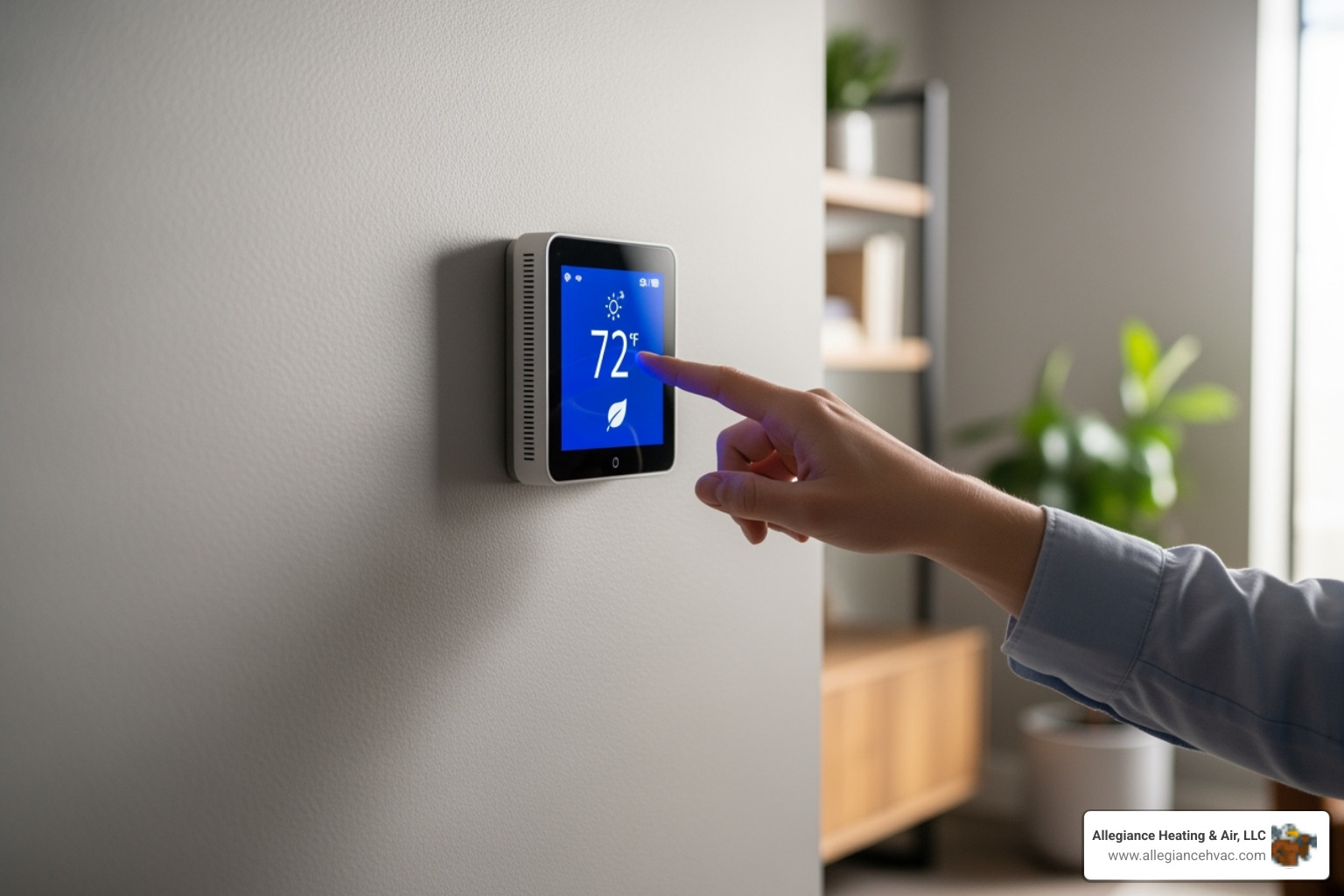Why Heating System Replacement is Essential for Your Home
Heating system replacement is essential when your current equipment can no longer efficiently or safely warm your home. Since heating and cooling account for 51% of your home’s energy use, an aging or failing system dramatically impacts your comfort and budget.
Key signs you need heating system replacement:
- System age: 15-20 years for most equipment
- Rising energy bills compared to previous years
- Costly and frequent repairs
- Uneven heating throughout your home
- Strange noises or unusual odors
- Safety concerns like yellow pilot lights
Most heating systems lose efficiency after 15-20 years. When a repair costs more than 50% of a new system’s price, or you’re facing multiple breakdowns in a season, replacement makes more financial sense.
Modern systems offer vast improvements in energy efficiency, with high-efficiency units achieving 90-95% AFUE ratings compared to the 60-80% of older systems. This upgrade translates to real savings, improved comfort, and lower energy bills. The decision is about long-term reliability, safety, and peace of mind for your family during cold winters.
When to Repair vs. Replace Your Heating System
A heating system breakdown presents a tough choice: repair or replace. It’s a decision that affects your family’s comfort and budget, and while there’s no single answer, reliable guidelines can help.
The age of your system is the first clue. After 15-20 years, breakdowns become more frequent. The 50% rule is a good guide: if a repair costs more than half the price of a new system, replacement is usually the better financial choice.
Rising energy costs are another red flag. If your bills are climbing, your system is likely losing efficiency. Beyond the numbers, safety concerns are paramount. A cracked heat exchanger in a gas furnace can leak deadly carbon monoxide. Inconsistent temperatures also signal a failing system.
Telltale Signs Your System Needs Replacing
Recognizing these distress signals can save you from a mid-winter emergency:
- System age over 15-20 years: Components wear out, even with good maintenance.
- Soaring utility bills: Compare this year’s bills to last year’s to see the trend.
- Frequent breakdowns: If you’re calling for repairs multiple times a season, you’re paying for a new system without getting one.
- Loud or unusual noises: Banging, grinding, or squealing indicate serious mechanical problems.
- Yellow pilot light: On gas systems, this is a serious safety hazard indicating possible carbon monoxide.
- Poor indoor air quality: Excessive dust or stuffiness can be linked to an old system or bad ductwork.
- Visible rust or cracks: These are immediate red flags, especially on the heat exchanger, often meaning replacement is the only safe option.
If you’re experiencing any of these issues, our team can help with Detecting Furnace Repair Needs and provide honest guidance.
The Financial Calculation: Repair Costs vs. Long-Term Savings
Focusing only on the immediate repair cost is a mistake; the hidden costs of an old system add up.
- Energy efficiency loss: An old 80% efficiency furnace may now operate closer to 65%, wasting money on heat that escapes your home.
- Future repair costs: One repair often leads to another, becoming a constant drain on your finances.
On the bright side, a new system offers significant benefits. It can lead to increased home value, and more importantly, provides the peace of mind that your family will stay warm and safe. Modern high-efficiency systems can cut heating costs by 20-40%, often paying for the upgrade over their lifespan while delivering superior comfort and reliability.
Exploring Your Heating System Replacement Options
When it’s time for a heating system replacement, you have several excellent options. The best choice depends on your home’s setup, local climate, and comfort preferences. We can help you steer these choices to find the perfect fit.
| System Type | Upfront Cost (General) | Operating Cost (General) | Lifespan (Avg.) | Best Climate/Notes |
|---|---|---|---|---|
| Furnaces | Moderate | Moderate (Gas) / Higher (Electric/Oil) | 15-30 years | All climates, especially cold; Requires ductwork |
| Boilers | Higher | Moderate (Gas) / Higher (Oil) | 15-30 years | All climates; No ductwork needed; Even heat |
| Heat Pumps | Moderate to High | Lower (Electric) | 10-15 years | Moderate climates; Provide heating & cooling |
Furnaces (Gas, Electric, Oil)
Furnaces are the most popular heating system, using forced-air to push warm air through ductwork for quick heating. When shopping, look for the AFUE (Annual Fuel Utilization Efficiency) rating. Modern high-efficiency models reach 95% or better, meaning less wasted fuel.
- Gas furnaces are common and cost-effective.
- Electric furnaces are reliable alternatives if gas isn’t available.
- Oil furnaces are less common but provide powerful heat.
Safety is critical with fuel-burning furnaces. Proper venting and annual inspections are essential to prevent carbon monoxide leaks. Our team provides safe, professional Furnace Replacement Services.
Boilers
Boilers use hydronic heating, circulating hot water or steam through radiators or radiant floor heating. This provides a gentle, even heat without circulating dust. While boilers have a higher installation cost, they are known for their longevity (15-30 years) and superior comfort. They are an excellent choice for homes without existing ductwork.
Heat Pumps (Air Source & Geothermal)
Heat pumps are an efficient all-in-one heating and cooling solution. Instead of burning fuel, they move heat from the outside air into your home. This process is highly efficient, measured by the HSPF2 rating (higher is better).
They are ideal for moderate climates. In very cold weather, they may need supplementary heat from a backup source. Many homeowners report improved comfort after switching to a heat pump. Learn more about our Heating Replacement Louisville KY services.
Ductless Mini-Split Systems
Ductless mini-split systems are a flexible solution for homes without traditional ductwork. They are ideal for additions, older homes, or converted spaces. A key benefit is zoned heating and cooling, allowing you to control the temperature in individual rooms. The quiet, wall-mounted units offer efficient heating and cooling with room-by-room control.
Key Factors in Your Heating System Replacement Decision
Choosing the right heating system replacement requires considering your unique situation, not just the price. The system must match your home’s specific needs.
Key factors to consider include:
- Home size and layout: A small ranch has different needs than a large two-story home.
- Local climate: Indiana winters demand a reliable heating source that can handle cold snaps.
- Fuel availability and cost: Natural gas is often the most cost-effective, but other options exist.
- Existing ductwork: The condition of your ducts is critical for efficiency.
- Budget: Consider the total cost of ownership, including energy bills and maintenance.
- Warranty: A good warranty protects your investment and provides peace of mind.
Choosing the Right Size for Your Heating System Replacement
Properly sizing your system is critical for comfort and efficiency. We measure heating capacity in BTUs (British Thermal Units). A system that is too large (oversized) or too small (undersized) will waste energy, provide poor comfort, and wear out prematurely.
To determine the correct size, we perform a professional Manual J calculation. This is a detailed analysis of your home’s specific heating needs, considering insulation, windows, climate, and more. Professional sizing is essential to get the most from your investment. Trust our expertise for proper sizing and Furnace Installation in Louisville KY.
Understanding Installation Costs and What’s Included
Our estimates are transparent and all-inclusive. The total investment includes:
- The system and brand you choose.
- Professional installation labor by licensed technicians.
- Ductwork modifications if needed.
- Permits and inspections to meet local safety codes.
- Removal and disposal of your old unit.
Proper installation is key to performance and safety. We are committed to Avoiding Furnace Installation Errors that could compromise your new system.
Maximizing Efficiency and Savings with Your New System
Pairing your new heating system with smart upgrades can lead to significant savings, as heating accounts for a large portion of home energy use.
To maximize your investment, consider:
- High-efficiency models: These units are engineered to convert more fuel into heat, wasting less energy.
- Smart thermostats: These devices learn your schedule and automatically adjust temperatures to save money.
- Zoning systems: Control different areas of your home independently, heating only the spaces you use.
- Regular maintenance: A well-maintained system runs more efficiently and lasts longer.
The Power of High-Efficiency Ratings (AFUE & HSPF2)
Understanding efficiency ratings is key to lowering your energy bills.
- AFUE (Annual Fuel Utilization Efficiency) measures furnace efficiency. A 95% AFUE model wastes only 5 cents per dollar on fuel, compared to 20 cents for an 80% AFUE model.
- HSPF2 (Heating Seasonal Performance Factor 2) measures a heat pump’s efficiency. A higher number means lower operating costs.
High-efficiency systems may cost more upfront, but the monthly savings often offset the initial investment. Our Guide Furnace Maintenance Replacement explains how proper care maintains peak efficiency.
Rebates, Tax Credits, and Financing
You don’t have to bear the full cost of a heating system replacement alone. Several programs can help:
- The Inflation Reduction Act (IRA) provides significant tax credits and rebates for energy-efficient upgrades.
- Federal energy tax credits can offer substantial savings on your tax return.
- State and local incentives and manufacturer rebates can provide additional savings.
We stay current on all available programs to help you maximize your savings. We also offer flexible financing options to help you manage the investment and start enjoying your new system right away.
Frequently Asked Questions about Heating System Replacement
Here are answers to common questions about heating system replacement.
How long does a typical heating system last?
Most heating systems have a lifespan of 15-20 years. Gas furnaces typically last 15-20 years, while heat pumps last 10-15 years. Boilers can last even longer, from 15 to 30 years. Regular upkeep is key to maximizing lifespan, as detailed in our Furnace Maintenance Tips. However, even a working older system is likely less efficient and costs more to run than a new model.
Can I install a new heating system myself?
No, this is a job for professionals. Heating system replacement involves high-voltage electricity, gas lines, and refrigerant handling, all of which require licensed, certified technicians to ensure safety and proper function. Professional installation is also necessary to meet local codes and keep your manufacturer’s warranty valid. A DIY attempt can lead to safety hazards, damaged equipment, and a voided warranty.
What is the best time of year to replace my heating system?
The best time is during the “shoulder seasons” of fall or spring. HVAC contractors are less busy, offering more scheduling flexibility. This allows you to make a planned, thoughtful decision rather than a rushed, emergency one when your system fails in the middle of winter. Planning ahead gives you peace of mind and can even lead to better deals.
Your Partner for a Warm and Comfortable Home
Choosing a heating system replacement is a major investment in your home’s comfort and value. With so many options, having the right partner is essential. This guide has covered the signs it’s time for a replacement and explored your options, from high-efficiency furnaces to versatile heat pumps.
Beyond choosing a system, professional installation is crucial. A properly sized and installed system ensures the safety, efficiency, and reliability your family deserves for the next 15-20 years.
Since 2005, Allegiance Heating & Air, LLC, a family-owned business, has served families in Greenville, IN, Louisville, KY, and throughout Southern Indiana and Kentucky. We treat every home as if it were our own. Our highly vetted technicians partner with you to find the perfect solution for your home and budget, guiding you through every step.
As your neighbors, we are a trusted, customer-first service provider committed to our community long after the installation is done.
Ready to take the next step toward reliable, efficient heating? Contact us for a professional consultation on your furnace installation in Louisville, KY and surrounding areas including Floyd County IN, Kentuckiana, Clarksville IN, Sellersburg IN, Jeffersonville IN, and Floyds Knobs IN. Let’s work together to keep your family warm and comfortable for years to come.

